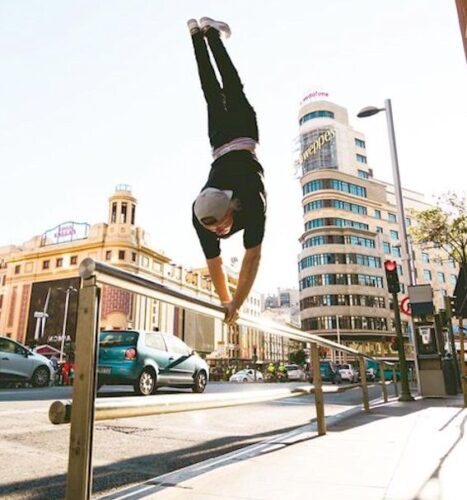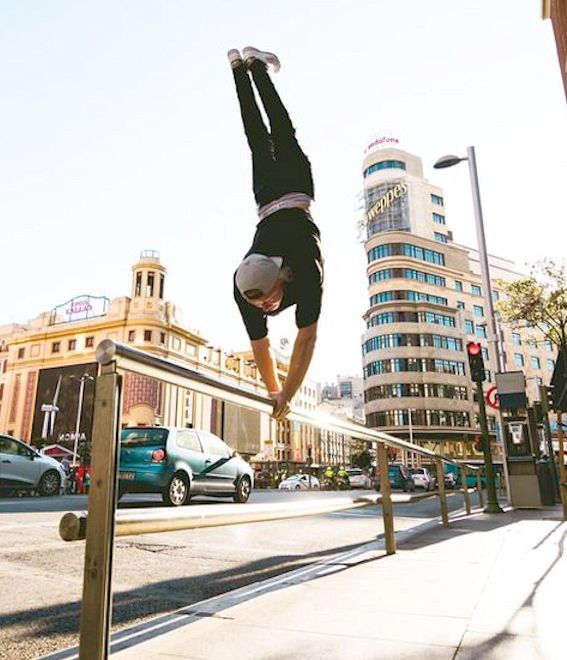
Parkour sport art, an article that describes the origin, the main features, the most famous athletes, the pro and cons of this modern spectacular activity.
Obstacles are found everywhere, and in overcoming them we nourish ourselves.
David Belle
The best part of falling is getting back up again.
David Belle
First, do it. Second, do it well. Third, do it well and fast — that means you’re a professional.
David Belle
Train not to get something right, train so that you can never get it wrong
David Belle
Parkour was never invented by anyone, it’s always been here.
Sebastien Foucan
Many people open their mind through different things like music and painting, as well as Parkour. How is not important. What is important is to open your mind because you gain some freedom through it.
David Belle
Parkour belongs to the ones who live it, not the ones who want to live thanks to it.
David Belle
Parkour teaches you to be sure of what you are able to do.
David Belle
When you’re training Parkour with passion, if you’re good, people will notice you. Don’t go around saying, ‘Hey look at this new move I got.’ No. We used to say, ‘If it’s good we’ll tell you.’ Do it for yourself first.
David Belle
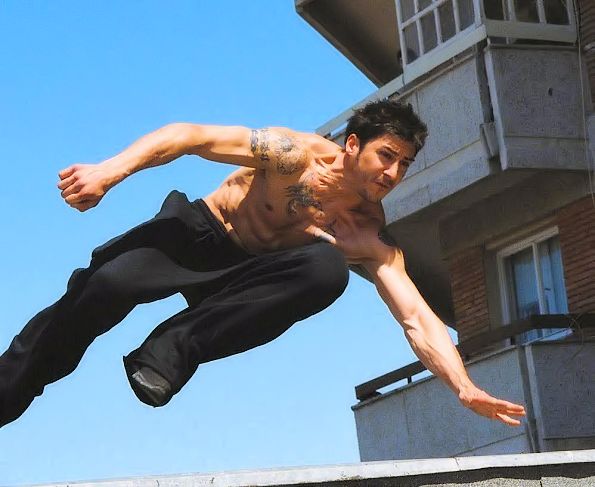
My thing from the beginning is to have it be useful, and be able to help others. It’s about being efficient and getting there as fast as you can. If people want to do it more artistically or in a freestyle way, I have absolutely no problem with it – that’s the way it’s going to evolve. It’s not my style, but if it’s other people’s [style], that’s perfect.
David Belle
The way of the parkour is to continue, not to stay here.
Sebastien Foucan
One of the main points of the philosophy behind parkour is being able to help people… To teach them they way themselves, to gain confidence in themselves, building up from simple moves to more complex things, to teach them that they are worthwhile people.
Chris Hayes
If someone puts you in front of a 30m high wall, tells you to get over it, and then comes back two years later and you’re still there, you’ve made no progress. You should find another wall.
David Belle
Understand that this art has been created by few soldiers in Vietnam to escape or reach: and this is the spirit I’d like parkour to keep. You have to make the difference between what is useful and what is not in emergency situations. Then you’ll know what is parkour and what is not. So if you do acrobatics things on the street with no other goal than showing off, please don’t say it’s parkour. Acrobatics existed long time ago before parkour.
David Belle
Parkour does not have to be liked or disliked! Parkour is here and it will stay here forever! Because it was born from a pure heart and nourished from all the love that a son can give to his father!
David Belle
If you are in front of a wall that you cannot get past, would you just keep banging your head into the wall?… No, you would find a new wall.
David Belle
So if you do acrobatics things on the street with no other goal than showing off, please don’t say it’s parkour. Acrobatics existed long time ago before parkour.
David Belle
A little backflip (backflips), but it’s not part of Parkour, but i like doing this since i did gym.
David Belle
A lot of people in their mind think ‘If there is a problem this is what I would do, this is how I would do it.’ But the truth is they don’t really know. Parkour teaches you to be sure of what you are able to do.
David Belle
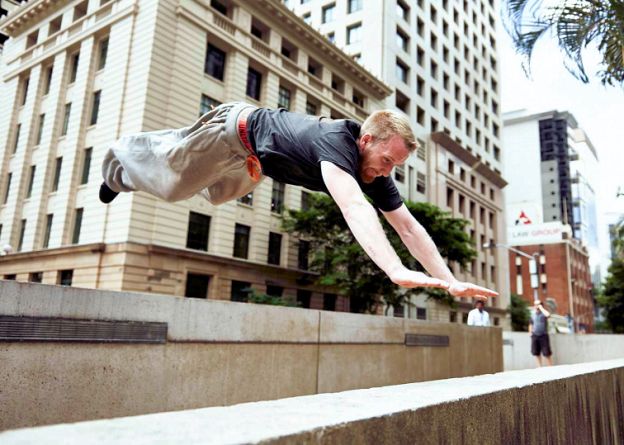
Parkour is a physical discipline that involves moving through obstacles in an efficient and fluid manner, using only the human body. Basic parkour movements include running, jumping, climbing, vaulting, and rolling. Parkour can improve physical fitness, agility, balance, coordination, and mental focus. It can also be a fun and challenging way to explore the environment and build confidence.
Parkour originated in France in the 1980s, specifically in the suburbs of Paris. David Belle is considered the founder of parkour. He developed the discipline along with his friends and family in the suburbs of Paris. He was inspired by his father, who was a firefighter and used his training to move efficiently in emergency situations. Belle and his friends also drew inspiration from military obstacle courses and martial arts.
The word parkour derives from parcours du combattant (obstacle course), the classic obstacle course method of military training proposed by Georges Hébert. Raymond Belle used the term “les parcours” to encompass all of his training including climbing, jumping, running, balancing, and the other methods he undertook in his personal athletic advancement.
David initially trained on his own, and after moving to Lisses, found other young men (including his cousins) who had similar desires, and they began to train together. The group eventually included David Belle, Sébastien Foucan, Châu Belle Dinh, Williams Belle, Yann Hnautra, Laurent Piemontesi, Guylain N’Guba Boyeke, Malik Diouf, and Charles Perrière. The group began calling themselves the Yamakasi, from the Lingala ya makási, meaning strong in one’s person, or “strong man, strong spirit”.
The group drew inspiration from Asian culture and Asian martial arts, notably the acrobatics of Jackie Chan such as qinggong displays in his Hong Kong action films, and the training philosophy of Bruce Lee, considering the latter to be the “unofficial president” of their group.
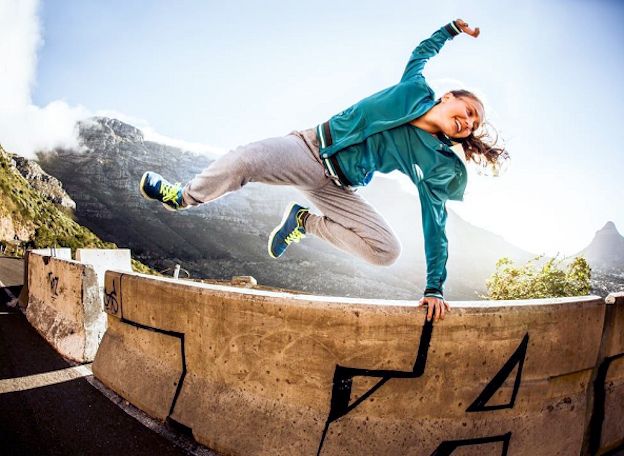
The group also was influenced by the Japanese manga and anime series Dragon Ball, in which the heroes attained extraordinary abilities through hard work, as well as the martial arts films of Belgian actor Jean-Claude Van Damme.
Parkour gained popularity through online videos and social media, as well as through Hollywood movies and TV shows that featured parkour stunts and performances. Some key principles of parkour include efficiency of movement, safety, and overcoming obstacles. Practitioners of parkour also emphasize the importance of training and conditioning the body to be able to move freely and fluidly.
Parkour involves completing a path through an urban environment with no assistance, no instruments and no help, just the human mind and the human body. Speed and effective movement are fundamental. You can run, climb, swing, jump, roll or crawl around, across, through, over and under obstacles in the town.
Anyone can do it, to the limit of their individual ability. It’s particularly popular among teenagers because it’s so free and individual – and cheap! It allows the individual to explore his or her own ability without competition, but many people do it in groups for company and fun. There are also jams, events where people spend some days together training with an expert.
Parkour is creative. It requires imagination. It’s a complete discipline, which develops the whole body and its coordination. Parkour athletes don’t need special spaces, special equipment or a lot of money. The ‘track’ is the town – walls, gates, barriers, benches, they’re all part of the challenge! Serious Parkour athletes insist that all athletes must clean or repair anything they dirty or damage in the town.
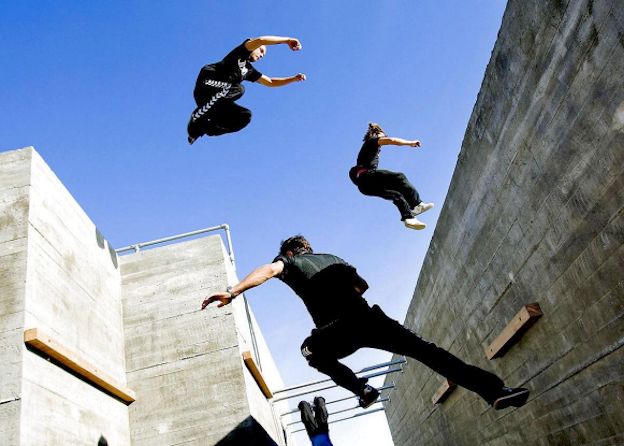
There are no judges, referees or umpires, no courts or courses, there are no team managers or trainers or coaches. There are no schools or federations to pay. You don’t need a bat, a racket, a board, a ball, a bow, a saddle or special strips, helmets or footwear (although a good pair of shoes is advisable!).
Parkour experts say it is a ‘state of mind’ and helps people to break down physical and emotional barriers, and develop self-confidence and critical thinking skills. It also encourages people to live their environment and interact with it.
Who is the world champion? Don’t ask that question! Expert Ron Doyle said, ‘That’s like asking, what’s the best song in the world?’. Another expert, Erwan Le Corre, declared, ‘Competition pushes people to fight against others for the satisfaction of a crowd and/or the benefits of a few business people. Parkour has an altruistic core of self-development.’
Therefore Parkour is an amazing physical discipline that promotes fitness, creativity, and quick thinking. It allows practitioners to express themselves in unique and challenging ways while also providing a fun and rewarding way to stay in shape. Certainly one need the physical skill and athleticism to practice it.
Parkour carries also some level of risk, but so do many other physical activities. The discipline has safety protocols and guidelines that must be followed to reduce the risk of injury. And while it may not serve a practical purpose in the traditional sense, it allows individuals to push themselves beyond their limits and explore their physical abilities in a unique and fulfilling way.

While parkour can be done in urban environments, it can also be done in safer and more controlled settings such as gymnastics facilities or in natural outdoor environments. And while it may not be for everyone, for those who are drawn to it, the benefits of the discipline go far beyond just staying in shape. It promotes mental toughness, problem-solving skills, and creativity.
Among the best Parkour athletes in the world we can quote Travis Verkaik, Edward Scott, Nathan Weston, Elis Torhal, Shay Rudolph, Dimitris Kyrsanidis, Christian Kovalevsky, Tim Shieff, Oliver Thorpe, Miranda Tibbling and George Magowan.
Red Bull Art of Motion is a parkour and free running competition, established in 2007 and created by Red Bull. It is an international competition with qualifiers being held in various regional competitions around the world throughout the year. Winners from the regional competitions each year earn their ticket to get to the finals, held towards the end of the year.
The inaugural competition was held in Vienna, Austria, and has since been held in various other countries, including England, Kuwait, United States, Sweden, Greece (Santorini), and most recently in Matera, Italy. Judging of the event is based on several criteria including creativity, flow, execution, and difficulty.
The WFPF is an organization of athletes from around the world, some on teams, some not, who’ve come together to help bring the sport and philosophy of Parkour to mainstream audiences everywhere. Like anything alive and exciting, Parkour is evolving.

Every person who makes a discovery and posts it on YouTube contributes to that process. By bringing together a diverse group of practitioners from all kinds of places and backgrounds, each with their own unique mentality, and each with deep roots in the wider community, the WFPF’s goal is that the voices of the movement will continue to shape that change in a positive direction.
You can also visit the following pages:

